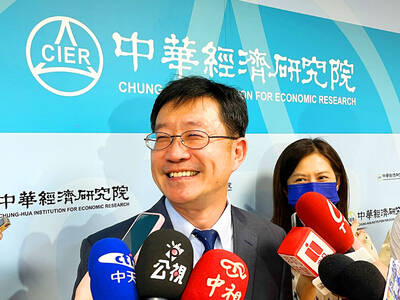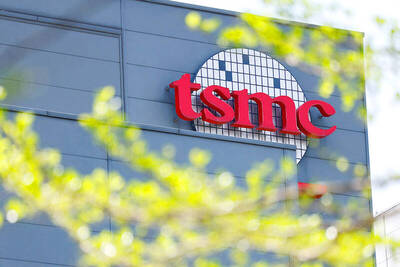Exports last month recorded another double-digit drop for the seventh consecutive month as demand from major trading partners remained weak, the Ministry of Finance said yesterday.
Outbound shipments last month declined 35.7 percent from last year to US$15.59 billion, while imports dropped 49.5 percent to US$12.17 billion, leaving a trade surplus of US$3.41 billion, the ministry’s latest data showed.
Lin Lee-jen (林麗貞), head of the ministry’s statistics department, said yesterday that the contraction, while sizable, had slowed from the 37.2 percent decline in January and February combined (to factor in the holiday effect) and a 41.9 percent plunge in December.
“The trade volume marked an increase of US$2.99 billion from a month earlier, indicating the slump [in exports] is not worsening,” Lin said, attributing the improvement to rush orders for consumer electronic products from China.
Shipments to China, including Hong Kong, fell 37.5 percent from a year earlier to US$6.3 billion, while exports to the US and Japan sank 22.4 percent and 34.5 percent to US$2.04 billion and US$1.03 billion respectively, the report showed.
Exports to Europe and ASEAN countries dropped 36 percent and 44 percent to US$1.73 billion and US$2.07 billion respectively, the report said.
Electronics, basic metals, plastics, chemicals and other major export products saw declines of between 22 percent and 58 percent. Shipments of bicycles were the exception, rising 3.3 percent to US$858 million from a year earlier, the report said.
In the first three months of the year, exports dropped 36.6 percent from last year to US$40.55 billion and imports plunged 47.2 percent to US$32.06 billion, resulting in a trade surplus of US8.49 billion.
Cheng Cheng-mount (鄭貞茂), head economist at Citigroup Taiwan Inc, said that the quarterly drop was a cause for concern.
Cheng, whose firm forecast the nation’s GDP would contract 8.2 percent in the first quarter, said the final results might turn out worse than expected.
“Despite rush orders, exports deteriorated more sharply than in the fourth quarter, when the drop hit 24.7 percent and the economy contracted 8.36 percent,” Cheng said by telephone.
Cheng said he would not be surprised if GDP contracted by 10 percent in the first quarter, even though the government put the decline at 6.51 percent.
Meanwhile, Tony Phoo (符銘財), chief economist at Standard Chartered Bank who has forecast that the economy would shrink by 4.9 percent in the first quarter, said talks of a recovery were premature as the US and European economies, the main consumers of Taiwanese exports, have yet to stabilize.

WEAKER ACTIVITY: The sharpest deterioration was seen in the electronics and optical components sector, with the production index falling 13.2 points to 44.5 Taiwan’s manufacturing sector last month contracted for a second consecutive month, with the purchasing managers’ index (PMI) slipping to 48, reflecting ongoing caution over trade uncertainties, the Chung-Hua Institution for Economic Research (CIER, 中華經濟研究院) said yesterday. The decline reflects growing caution among companies amid uncertainty surrounding US tariffs, semiconductor duties and automotive import levies, and it is also likely linked to fading front-loading activity, CIER president Lien Hsien-ming (連賢明) said. “Some clients have started shifting orders to Southeast Asian countries where tariff regimes are already clear,” Lien told a news conference. Firms across the supply chain are also lowering stock levels to mitigate

IN THE AIR: While most companies said they were committed to North American operations, some added that production and costs would depend on the outcome of a US trade probe Leading local contract electronics makers Wistron Corp (緯創), Quanta Computer Inc (廣達), Inventec Corp (英業達) and Compal Electronics Inc (仁寶) are to maintain their North American expansion plans, despite Washington’s 20 percent tariff on Taiwanese goods. Wistron said it has long maintained a presence in the US, while distributing production across Taiwan, North America, Southeast Asia and Europe. The company is in talks with customers to align capacity with their site preferences, a company official told the Taipei Times by telephone on Friday. The company is still in talks with clients over who would bear the tariff costs, with the outcome pending further

Six Taiwanese companies, including contract chipmaker Taiwan Semiconductor Manufacturing Co (TSMC, 台積電), made the 2025 Fortune Global 500 list of the world’s largest firms by revenue. In a report published by New York-based Fortune magazine on Tuesday, Hon Hai Precision Industry Co (鴻海精密), also known as Foxconn Technology Group (富士康科技集團), ranked highest among Taiwanese firms, placing 28th with revenue of US$213.69 billion. Up 60 spots from last year, TSMC rose to No. 126 with US$90.16 billion in revenue, followed by Quanta Computer Inc (廣達) at 348th, Pegatron Corp (和碩) at 461st, CPC Corp, Taiwan (台灣中油) at 494th and Wistron Corp (緯創) at

NEGOTIATIONS: Semiconductors play an outsized role in Taiwan’s industrial and economic development and are a major driver of the Taiwan-US trade imbalance With US President Donald Trump threatening to impose tariffs on semiconductors, Taiwan is expected to face a significant challenge, as information and communications technology (ICT) products account for more than 70 percent of its exports to the US, Chung-Hua Institution for Economic Research (CIER, 中華經濟研究院) president Lien Hsien-ming (連賢明) said on Friday. Compared with other countries, semiconductors play a disproportionately large role in Taiwan’s industrial and economic development, Lien said. As the sixth-largest contributor to the US trade deficit, Taiwan recorded a US$73.9 billion trade surplus with the US last year — up from US$47.8 billion in 2023 — driven by strong